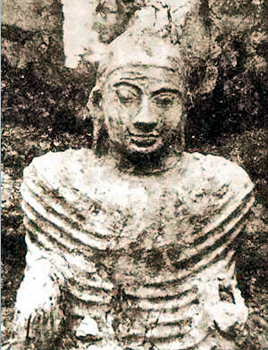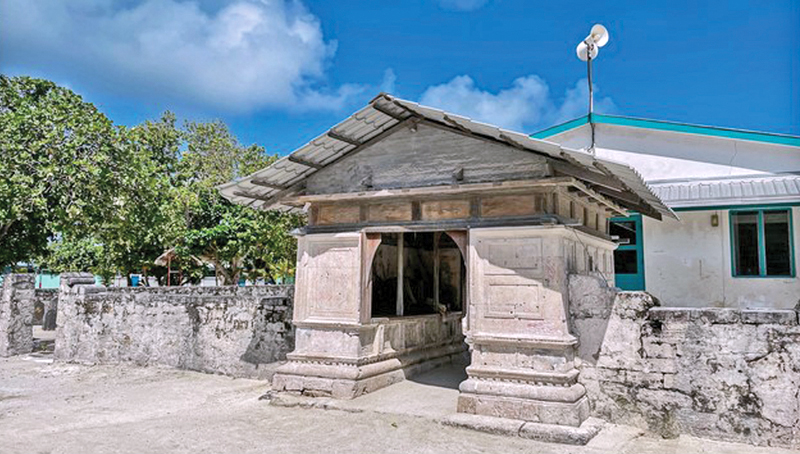The Maldives is a 100 percent Muslim country. But Buddhism was the dominant religion here for more than 1,000 years before the advent of Islam in 1153 CE.
According to a website of the Maldivian Government, the Indian Ocean archipelago was first inhabited around 1500 BCE. The first permanent settlers were Aryan immigrants who had also colonised Sri Lanka at around the same time. Subsequent migrations at regular intervals from Southern India and Sri Lanka served to expand the population of the Maldives.
 Buddhism was introduced to the Maldives around the time it was introduced in Sri Lanka by the Indian Emperor Asoka (in the Third Century BCE). A series of Buddhist dynasties ruled the Maldives until King Siri Bavanditta Maha Radun (aka King Dhovemi) converted to Islam in 1153 CE and took the name Sultan Muhammad al-Adil.
Buddhism was introduced to the Maldives around the time it was introduced in Sri Lanka by the Indian Emperor Asoka (in the Third Century BCE). A series of Buddhist dynasties ruled the Maldives until King Siri Bavanditta Maha Radun (aka King Dhovemi) converted to Islam in 1153 CE and took the name Sultan Muhammad al-Adil.
However, despite having Muslim personal names, Maldivian Sultans assumed Sanskritic titles such as Sri (Siri), Keerthi and Loka. And all had the title Maha Radun (or Maha Raja). The title of the last king of the Maldives Sir Muhammad Fareed Didi was Keerithi Maha Radun (Keerthi Maha Raja).
Some dynasties considered themselves as belonging to the Aditta (Aditya or Solar) clan and some to the Soma (Lunar) clan in the Indian Kshatriya (Rajput) tradition.
Buried stupas
Buried in the islands of the Maldivian archipelago, there are ruins of Buddhist temples. There are over 500 of these in the archipelago.
The buried stupas need to be excavated and saved from the erosive equatorial climate.
The Foah’mati site on the Nilandhoo island has a Buddhist temple believed to be of the 12th Century CE, built on the orders of King Dharumavantha Rasgefaanu around 1141.
Dharumavantha Rasgefaanu was none other than King Dhovemi, who converted to Islam in 1153 and continued to rule the Maldives as Sultan Muhammad al Adil. The temple was excavated by a Norwegian team of archaeologists led by explorer Thor Heyerdahl in the 1980s.
In 1990, Maldivian historian Hassan Ahmed Maniku counted as many as 59 islands with Buddhist archaeological sites.
Thodoo Temple
The largest monuments of the Buddhist era are in the islands fringing the Eastern side of Haddhunmathi Atoll (Laamu Atoll). Notable historical and cultural sites include the Thoddoo Buddhist Temple and the Kuruhinna Tharaagandu, an ancient Buddhist monastery dating back to the 6th and 7th Centuries.
Dhaalu Atoll, the capital island of the atoll Kudahuvadhoo, has traces of a once magnificent Buddhist temple.
Though much of the temple was lost during the transition to Islam, a remarkable gateway stands as a poignant testament to the complex history of this island nation.
It serves as a reminder of the shared history that has shaped the Maldivian identity.
In the islands of Gan and Fua Mulaku, the colonial-era archaeologist H. C. P. Bell documented the existence of stupas, finials, capitals, pillars, carved stones, images, beads and jars and a vatadage (circular relic house) – all of which indicate just how deep-rooted Buddhist culture was in the Maldives in those far off times.
The inscriptions also indicate that the people of Kudahuvadhoo embraced Islam 88 years after the country officially adopted the faith, signifying a period of gradual cultural and religious transition. Among Kudahuvadhoo’s hidden wonders are the mysterious mounds known as hawittas. These are ruins of Buddhist temples from the pre-Islamic era that are yet to be excavated.

The Buddha statue on Thoddu island in the Maldives
According to Indian Express, a coral block was found at the Maabadhige archaeological site, with inscriptions on four sides of the block, depicting a version of the Southern Brahmi script from the Tamil Pallava period (275 CE to 897 CE). Historians consider this inscription to be the oldest surviving script to be found in the Maldives.
One of the inscriptions is a mantra of Vajrayana Buddhism, a form of Buddhism that had existed in the Maldives in ancient times. The letters show some resemblance to the later Evela Akuru, leading to the theory that this early script may have played a part in the formation of the first known Dhivehi alphabet.
Copper plate inscriptions
Many ancient Maldivian historical texts are found only in Loamaafaanu form, (in copper plate form), with the oldest of the plates dating from the 12th Century CE. The first Loamaafaanu plates were discovered in 1922 during an expedition which was supervised by British archaeologist H.C.P. Bell.
Dhivehi and Sinhalese
German linguist, Sonja Fritz, says in her paper “A Descriptive and Historical Grammar of Maldivian and Its Dialects” (Heidelberg University, 2002) that Dhivehi, the official language of the Maldives, represents the Southernmost Indo-Aryan language along with Sinhalese.
“Without considering Sinhalese, a well-founded investigation of Dhivehi is practically impossible. Many Dhivehi words would sound very familiar to the Sinhalese,” Fritz says.
“The very early Dhivehi texts were written in a script named Dives Akuru (“Sanskrit Akshara/Sinhalese Akuru), the oldest type of which is called Evela Akuru (“script of that time”), Fritz adds.
“It is quite obvious that this syllabary must be related to the medieval Sinhalese script. Like the latter, it must be classified as a subtype of a Southern Brahmi,” she says.
Three articles by the Sinhalese philologist M.W.S. de Silva (written between 1969 and 1970) were the first efforts to investigate the Dhivehi language on the basis of modern linguistic methods. For the first time, de Silva tried to elucidate and explain the relationship between Dhivehi and Sinhalese.
Place names such as Lankafuri (‘Lankapura or City of Lanka) and Viha Mana Furi (Vihara Mana Pura or ‘Delightful City of Buddhist Monasteries) are easily recognisable to those conversant with the Sinhala Language.
Iconoclastic phase
Being opposed to idol worship, Maldivian converts to Islam destroyed many of the Buddhist temples over the years. But Nilandhoo Island stands as a testament to the resilience of Buddhism. It was the last stronghold of Buddhism in the Maldives and it witnessed resistance against the spread of Islam.
After the Maldives was declared an Islamic kingdom by royal decree in 1153, Thoddoo islanders, who were protective about the Buddhist stupas, removed the statue of the Buddha from a higher position and placed it upright on the floor of the temple, where sand had been spread. It was then surrounded by hewn stone slabs and more sand and rocks. A protective slab was placed over the statue and additional rocks and sand were added to the pile until the temple had become a mound. The heap was then covered in soil.
Preserving the heritage
The Maldives is now preserving its pre-Islamic heritage against many odds. Until the mid-1990s, it was socially unacceptable for people to study other religions, Indian Express points out.
In 2012, the country’s National Museum was vandalised, where close to 30 Buddhist statues, some dating to the sixth century, were destroyed. Some of these coral and lime statues were so severely damaged that restoration was impossible.
At that time, a New York Times report quoted officials saying that a group of men had vandalised the museum because they believed that the statues were idols, and therefore, illegal under Islamic and national laws. The destruction meant that almost all of the museum’s pre-Islamic collection was lost. Even today, no image or idol can be taken to the Maldives.
Till 2019, the Maldives had no legal framework to penalise the destruction of cultural heritage.
Indian help
India gave a grant of approximately 4 million Maldivian rufiyaa to help restore one of the many Buddhist sites in the Maldives. The grant was used to establish a museum in Landhoo island, 190 kms North of the capital Malé.
In 1987, under the SAARC technical assistance program, a three-member team from the Archaeological Survey of India (ASI) visited the Maldives, along with M.I. Loutfi, director of the National Centre of Linguistic and Historical Research in Malé, to carry out investigations of and survey pre-Islamic remains in the country.
Maldivians now see the need to protect their pre-Islamic heritage because they are tourist attractions. Heritage tourism generates income for the locals.






